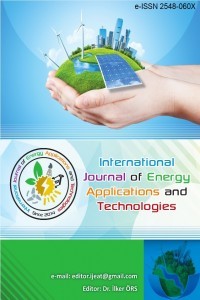Electromechanical modeling of energy harvesting for FRP composite structures coupled with piezoelectric transducers
Electromechanical modeling of energy harvesting for FRP composite structures coupled with piezoelectric transducers
Supplanting of metals by composites is on the rise for the last three decades in the aerospace, marine and automotive industry following the trend of electrification and indigenous design approaches. In parallel, piezoelectric (PZT) sensors and energy harvesters have gained significant attention due to their applicability and efficacy for microscale power generation systems. From a new perspective, embedding PZT sensors into composite structures will be beneficial in many aspects. Condition monitoring can be performed by using the sensing capability of PZTs while vibration can be controlled by means of its excitation capability. Besides, energy harvesting can be employed due to the mechanical forces exerted on the coupled structure. It is critical to create an accurate numerical modeling of electromechanical coupling for the investigation of efficiency of PZT sensors. In this paper, electromechanical modeling of a Fiber Reinforced Polymer (FRP) composite structure with an embedded PZT patch is presented and validated with an experimental setup. Afterwards, the energy harvesting capability of a PZT patch embedded in the FRP structure is investigated.
___
- M. K. Stojčev, M. R. Kosanović, L. R. Golubović, “Power management and energy harvesting techniques for wireless sensor nodes.” 9th Int. Conf. on Telecommunication in Modern Satellite, Cable, and Broadcasting Services (IEEE), 2009. https://doi.org/10.1109/TELSKS.2009.5339410
- M. Safaei, H. A. Sodano, and S. R. Anton, “A review of energy harvesting using piezoelectric materials: state-of-the-art a decade later (2008–2018),” Smart Mater. Struct. 28, pp. 62, 2019.
- L. Bruant, G. Coffignal, F. Lene, and M. Verge, "Active control of beam structures with piezoelectric actuators and sensors: modeling and simulation," Smart Materials and Structures, 2001, vol. 10, pp. 404-408.
- Y. Shen and A. Homaifar, "Vibration Control of Flexible Structures with PZT Sensors and Actuators," Journal of Vibration and Control, vol. 7, pp. 417-451, 2001.
- A. Erturk and D. J. Inman, "A Distributed Parameter Electromechanical Model for Cantilevered Piezoelectric Energy Harvesters," Journal of Vibration and Acoustics, 2008, vol. 130, pp. 041002-15.
- M. I. Friswell and S. Adhikari, "Sensor shape design for piezoelectric cantilever beams to harvest vibration energy," Journal of Applied Physics, 2010, vol. 108, pp. 014901-6.
- Y. Aoki, P. Gardonio, M. Gavagni, C. Galassi, and S. J. Elliott, "Parametric Study of a Piezoceramic Patch Actuator for Proportional Velocity Feedback Control Loop," Journal of Vibration and Acoustics, 2010, vol. 132.
- Y. Aoki, P. Gardonio, and S. J. Elliott, "Rectangular plate with velocity feedback loops using triangularly shaped piezoceramic actuators: Experimental control performance," Journal of the Acoustical Society of America, 2008, vol. 123, pp. 1421-1426.
- Y. Aoki, P. Gardonio, and S. J. Elliott, "Modelling of a piezoceramic patch actuator for velocity feedback control," Smart Materials and Structures, 2008, vol. 17, p. 015052.
- Z. Zyszkowski, Podstawy Elektroakustyki; WNT: Warszawa, Poland, 1984.
- J. G. Smits, S. I. Dalke, and T. K. Cooney, “The constituent equations of piezoelectric bimorph.” Sens. Actuators A Phys. 1991, 28, 41–61.
- X. J. Dong, and G. Meng, “Dynamic analysis of structures with piezoelectric actuators based on thermal analogy method.” Int. J. Adv. Manuf. Technol. 2006, 27, 841–844.
- H. Allik and T. J. R. Hughes, “Finite element method for piezoelectric vibration,” International Journal for Numerical Methods in Engineering, 1970, vol. 2, no. 2, pp. 151–157.
- A. Benjeddou, “Advances in piezoelectric finite element modeling of adaptive structural elements: a survey,” Computers and Structures, 2000, vol. 76, no. 1, pp. 347–363.
- V. Nguyen, P. Kumar, and J.Y.C. Leong, “Finite Element Modelling and Simulations of Piezoelectric Actuators Responses with Uncertainty Quantification”, Computation, 2018, 6, no. 4: 60.
- E. Carrera, S. Valvano, and G. M. Kulikov, “Electro-mechanical analysis of composite and sandwich multilayered structures by shell elements with node-dependent kinematics.” Int. J. Smart Nano Mater. 2018, 9, 1–33.
- S. Avdiaj, J. Setina, and N.Syla, “Modeling of the piezoelectric effect using the Finite Element Method”, Materials and Technology 43, 2009, 6, pp. 283-291.
- F. Qian, Y. Liao, L. Zuo, P. Jones, “System-level finite element analysis of piezoelectric energy harvesters with rectified interface circuits and experimental validation.”, Mechanical Systems and Signal Processing, 2021, 151, 107440.
- Y. Kuang, Z. J. Chew, M. Zhu, “Strongly coupled piezoelectric energy harvesters: Finite element modelling and experimental validation”, Energy Conversion and Management, 2020, 213, 112855.
- R. C. Dash, D. K. Maiti and B. N. Singh, “A finite element model to analyze the dynamic characteristics of galloping based piezoelectric energy harvester”, Mechanics of Advanced Materials and Structures, 2021. DOI: 10.1080/15376494.2021.1921316
- Y. Song, “Finite-element implementation of piezoelectric energy harvesting system from vibrations of railway bridge”, Journal of Energy Engineering, 2019, vol.145
- A. Roy Chowdhury, N. Saurabh R. Kiran, S. Patel, “Effect of porous auxetic structures on low-frequency piezoelectric energy harvesting systems: a finite element study.”, Appl. Phys. A 2022, 128, 62. https://doi.org/10.1007/s00339-021-05199-w
- IEEE Standard on Piezoelectricity ANSI/IEEE Std 176-1987, ed, 1988.
- Yayın Aralığı: Yılda 2 Sayı
- Başlangıç: 2014
- Yayıncı: İlker ÖRS
